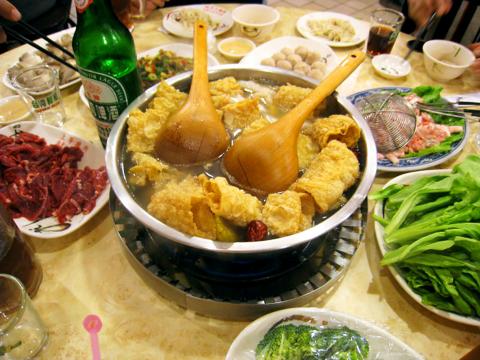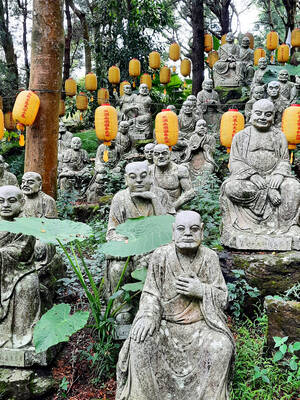Shangching Sheep Hot Pot Restaurant (尚青ㄟ羊肉爐), located in the depths of Sanchong (三重), likes to flaunt a hard-core image. It’s tactic, which involves hanging whole sheep carcasses outside the main entrance next to a slab so that diners can view the butchering of the raw meat, has certainly generated a hearty response. Some are disgusted by the spectacle, and have expatiated at length on various food blogs, even going so far as to draw a parallel with the public slaughter and the skinning of snakes that was once a popular attraction at the Huaxi Street (華西街) night market. There are others, myself included, who are attracted by the offer of fresh mutton that these carcasses promise.
There are many factors that distinguish Shangching from run-of-the-mill mutton hot pot establishments, which often use frozen meat taken from goats rather than sheep. The management emphasizes that it uses local sheep that are killed and delivered to the restaurant daily. Another factor is the absence of a broth heavy with Chinese medicinal herbs. Shangching uses a clear broth made from bones, rice wine and very little else.
Walking into Shangching is more like walking into a butcher’s shop than a restaurant, which is a deliberate move that gives the meat pride of place. Customers place orders before a display of a huge variety of meats and animal parts. This process can be a bit bewildering for those unable to recognize the various cuts of meat and unfamiliar with how they should be incorporated into the meal. The servers are not particularly helpful in this regard, and given that often there are queues for a table, they probably feel little need to go out of their way to explain things to first-timers.

Photo: Ian Bartholomew, Taipei Times
It is largely up to the customer to determine the flavor of the broth through the selection of meat. A good start is a plate of head meat (鍋底嘴邊肉, NT$450), and for those who want to enrich the broth further, a sheep’s tail (羊尾巴, NT$250) or foot (羊腳, NT$250) can be recommended. A wide range of vegetables are available to add a little sweetness, and these are sold at NT$50 a plate. For those willing to splash out, a 300g plate of top quality loin (涮腰內肉, NT$700) provides some of the most tender mutton you’re likely to find. Cartilage (軟骨肉, NT$500) and shank (腱子肉, NT$600) provide contrasting textures. For those who want to push the boundaries, sheep brains (羊腦, NT$150) and eyes (羊眼睛, NT$100 each) can be recommended both for their culinary interest and relative absence from conventional hot pot menus. Attention needs to be paid to developing the broth with judicious ordering, otherwise it will remain bland and unappealing.
Not everything on offer goes into the hot pot, and Shangching has a number of other methods of preparation. The fat belly meat (三層白切肉, NT$450), thinly sliced, is delicious, as is the intestine fried with ginger (炒薑絲羊腸, NT$150).
The hot pot and other dishes should be enjoyed with a plate of vermicelli in sheep’s oil (羊油麵線), which is very tasty, but certainly not for those who don’t like the smell of mutton.
Fans of British culinary legend Fergus Henderson, a man who has spent his career advocating the use of “the whole beast,” rather than the few prize cuts available in the supermarket, are likely to find great interest in what Shangching has to offer.
With its roadside-stall atmosphere and commensurate level of comfort, Shangching will seem expensive for anyone who is not there specifically for the food, but as a destination for culinary adventure, it’s hard to beat.

When Taiwan was battered by storms this summer, the only crumb of comfort I could take was knowing that some advice I’d drafted several weeks earlier had been correct. Regarding the Southern Cross-Island Highway (南橫公路), a spectacular high-elevation route connecting Taiwan’s southwest with the country’s southeast, I’d written: “The precarious existence of this road cannot be overstated; those hoping to drive or ride all the way across should have a backup plan.” As this article was going to press, the middle section of the highway, between Meishankou (梅山口) in Kaohsiung and Siangyang (向陽) in Taitung County, was still closed to outsiders

President William Lai (賴清德) has championed Taiwan as an “AI Island” — an artificial intelligence (AI) hub powering the global tech economy. But without major shifts in talent, funding and strategic direction, this vision risks becoming a static fortress: indispensable, yet immobile and vulnerable. It’s time to reframe Taiwan’s ambition. Time to move from a resource-rich AI island to an AI Armada. Why change metaphors? Because choosing the right metaphor shapes both understanding and strategy. The “AI Island” frames our national ambition as a static fortress that, while valuable, is still vulnerable and reactive. Shifting our metaphor to an “AI Armada”

US President Donald Trump may have hoped for an impromptu talk with his old friend Kim Jong-un during a recent trip to Asia, but analysts say the increasingly emboldened North Korean despot had few good reasons to join the photo-op. Trump sent repeated overtures to Kim during his barnstorming tour of Asia, saying he was “100 percent” open to a meeting and even bucking decades of US policy by conceding that North Korea was “sort of a nuclear power.” But Pyongyang kept mum on the invitation, instead firing off missiles and sending its foreign minister to Russia and Belarus, with whom it

The Chinese Communist Party (CCP) has a dystopian, radical and dangerous conception of itself. Few are aware of this very fundamental difference between how they view power and how the rest of the world does. Even those of us who have lived in China sometimes fall back into the trap of viewing it through the lens of the power relationships common throughout the rest of the world, instead of understanding the CCP as it conceives of itself. Broadly speaking, the concepts of the people, race, culture, civilization, nation, government and religion are separate, though often overlapping and intertwined. A government